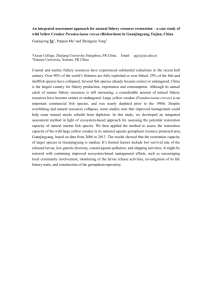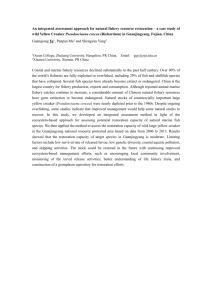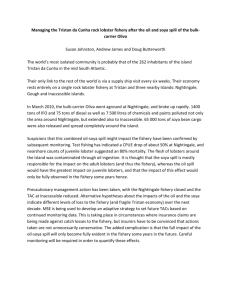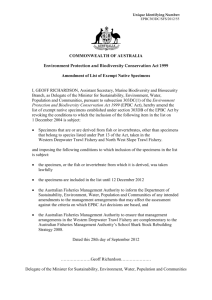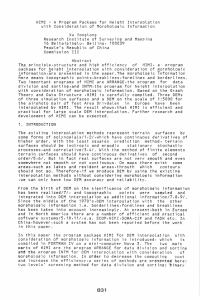Summary-of-management-environment-and-research-measures
advertisement
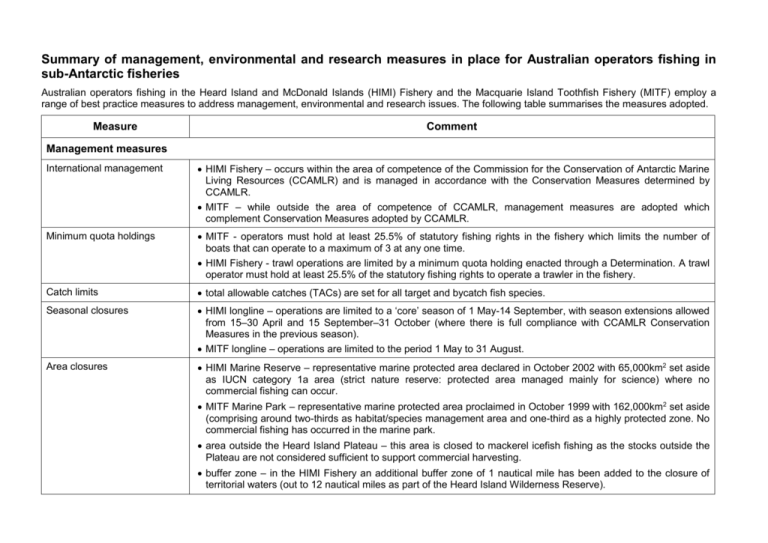
Summary of management, environmental and research measures in place for Australian operators fishing in sub-Antarctic fisheries Australian operators fishing in the Heard Island and McDonald Islands (HIMI) Fishery and the Macquarie Island Toothfish Fishery (MITF) employ a range of best practice measures to address management, environmental and research issues. The following table summarises the measures adopted. Measure Comment Management measures International management HIMI Fishery – occurs within the area of competence of the Commission for the Conservation of Antarctic Marine Living Resources (CCAMLR) and is managed in accordance with the Conservation Measures determined by CCAMLR. MITF – while outside the area of competence of CCAMLR, management measures are adopted which complement Conservation Measures adopted by CCAMLR. Minimum quota holdings MITF - operators must hold at least 25.5% of statutory fishing rights in the fishery which limits the number of boats that can operate to a maximum of 3 at any one time. HIMI Fishery - trawl operations are limited by a minimum quota holding enacted through a Determination. A trawl operator must hold at least 25.5% of the statutory fishing rights to operate a trawler in the fishery. Catch limits total allowable catches (TACs) are set for all target and bycatch fish species. Seasonal closures HIMI longline – operations are limited to a ‘core’ season of 1 May-14 September, with season extensions allowed from 15–30 April and 15 September–31 October (where there is full compliance with CCAMLR Conservation Measures in the previous season). MITF longline – operations are limited to the period 1 May to 31 August. Area closures HIMI Marine Reserve – representative marine protected area declared in October 2002 with 65,000km2 set aside as IUCN category 1a area (strict nature reserve: protected area managed mainly for science) where no commercial fishing can occur. MITF Marine Park – representative marine protected area proclaimed in October 1999 with 162,000km2 set aside (comprising around two-thirds as habitat/species management area and one-third as a highly protected zone. No commercial fishing has occurred in the marine park. area outside the Heard Island Plateau – this area is closed to mackerel icefish fishing as the stocks outside the Plateau are not considered sufficient to support commercial harvesting. buffer zone – in the HIMI Fishery an additional buffer zone of 1 nautical mile has been added to the closure of territorial waters (out to 12 nautical miles as part of the Heard Island Wilderness Reserve). Measure Comment Move-on rules HIMI Fishery - a ‘move-on’ rule applies where vessels are required to move at least 5 nautical miles if fish bycatch limits specified by CCAMLR are triggered or where a percentage of the mackerel icefish catch is below the set size limit of 240 millimetres. Stock assessments peer-reviewed integrated stock assessments are carried out each year as a basis for setting TACs for target species. Fishery independent data HIMI Fishery – a random stratified trawl survey and the results of an extensive tagging program (23,383 tags deployed since program began in 1997) are key inputs to the stock assessments. This work is estimated to cost industry in excess of $500,000 per year. MITF – the results from a tagging program (12,996 tags deployed since program began in 1995) are a key input to the annual toothfish stock assessment. Harvest strategies precautionary harvest strategies are adopted for the target species in each fishery. HIMI Fishery and MITF (toothfish) – that the probability that spawning biomass will fall below 20% of the pre exploitation level over the 35 year projection period must not exceed 0.1 and the median escapement for the Fishery of the spawning biomass shall not be less than 50% over a 35 year projection. HIMI Fishery (mackerel icefish) - that the probability that spawning biomass will fall below 20% of the pre exploitation level over the two year projection period must not exceed 0.1 and the median escapement for the Fishery of the spawning biomass shall not be less than 75% over a two year projection. In November 2011, CCAMLR adopted the following limit reference point to apply to mackerel icefish: where the stock assessment indicates a stock biomass of less than 1000 tonnes, or the decision rules indicate a catch limit of less than 100 tonnes, a commercial catch would not be set. Instead, a 30 tonnes combined research and bycatch limit would apply, which would allow the annual trawl survey to continue to monitor the stock and accommodate by-catch of icefish that may occur in toothfish trawl fishery. Observers 2 observers are deployed on each voyage to collect data, monitor fishing operations and undertake wildlife observations. MSC certification the Marine Stewardship Council (MSC) has certified all the target species in Australia’s sub-Antarctic fisheries: Patagonian Toothfish and Mackerel Icefish in the HIMI Fishery and Patagonian Toothfish in the MITF which recognises the fisheries as being sustainable and well managed. The MSC is an independent global non-profit organisation which has developed an eco-labelling certification process providing a means to encourage sustainable fishing by recognising world’s best practice in resource management. Measure Comment Environmental measures Offal retention the discharge of dead fish, fish offal or by-products of fish processing is not permitted in order to minimise the feeding opportunities for seabirds and marine mammals around vessels. Minimisation of lighting reduced lighting to minimise risk of seabirds colliding with vessels. Plastic packaging ban prohibition on the use of plastic packaging bands to avoid injury or death, through ingestion or entanglement, of wildlife. Mitigation measures – longline a range of mitigation measures have been developed to minimise interactions with seabirds and marine mammals in demersal longline fisheries. The measures, additional to the offal retention requirement and seasonal closures (outlined above), include: Mitigation measures - trawling integrated weight line – the line is capable of achieving a sink rate of 0.2 metres per second (CCAMLR standard) to limit the time baits are available to seabirds; night setting - setting can only occur during the hours of darkness between the times of nautical twilight in the MITF; paired streamer lines - use of a streamer line (with specifications to type and dimensions of streamer line) to scare birds away from gear during line setting operations; bird excluder devices or a ‘brickle curtain’ – this device is designed to discourage birds from accessing baits during the line hauling operations; and stern setting tube – this is an innovation developed by Australian Longline Pty Ltd for the vessel ‘Antarctic Chieftain’ to avoid seabirds accessing baits during longline setting operations. a range of measures have been developed to address target species and bycatch issues in trawl fisheries. The measures, additional to the offal retention requirement and ‘move-on’ rule (outlined above), include: to avoid seabird interactions no midwater trawling occurs during the period 1 February to 31 March each year. At all other times midwater trawling can only occur at night; additional seabird interaction mitigation strategies include the removal of the ‘stickers’ from the net prior to the trawl being shot away, ensuring the trawl deck is swept clean of any fish, aiming to keep the meshes closed when the net is on the surface by maintaining a practical speed, monitor the number of birds around the boat and not shoot away where there is a significant risk of seabirds becoming entangled; and trawl gear restrictions (bobbin diameter and mesh size) are used to minimise the impact on benthic habitat and assist escapement of juvenile target species and bycatch finfish species. Measure Comment Ecological Risk Assessments Ecological Risk Assessments (ERAs) have been completed on 5 sub-fisheries (HIMI demersal trawl, HIMI midwater trawl, HIMI demersal longline, MITF demersal trawl and MITF demersal longline) and Ecological Risk Management (ERM) reports prepared. The reports conclude that there are no target, bycatch, byproduct or protected species considered to be at high risk from the effects of fishing. Other measures prohibition on the disposal of poultry products and vegetable scraps from the Brassica family to minimise the possibility of the introduction of disease or pests on the Islands. Research measures Fishery Assessment Plans the management plans for the HIMI Fishery and MITF require that an annual Fishery Assessment Plan be prepared to provide for an adequate program of monitoring to ensure that reliable stock assessments can be made for each target species and for monitoring the direct impact of the fishery on non-target species and ecosystem. In the HIMI Fishery, this amounts to around 20 days of vessel time per year, with the major component being the annual random stratified trawl survey. Benthic impacts research the Fisheries Research and Development Corporation has co-funded the Australian Antarctic Division to assess ‘demersal fishing interactions with marine benthos in the Australian EEZ of the Southern Ocean: an assessment of the vulnerability of benthic habitats to impact by demersal gears’. The development and use of camera equipment capable of fishing in waters up to 2000 metres is a key component of the project. The total project cost over 4 years is around $3.1 million with industry contributing around $1 million in vessel time to deploy cameras and undertake beam trawls. A final report from the project is expected in mid 2012. Conservation zones in the HIMI Fishery research has been undertaken by commercial fishing vessels to assess the conservation and fishery values of four Conservation Zones. An assessment is currently being undertaken by the Australian Antarctic Division to determine whether some or all of these areas get incorporated into the HIMI Marine Reserve. This process is expected to be completed by October 2012. MITF stock assessment industry has funded CSIRO to develop a multi-gear spatially explicit assessment and management strategy evaluation for the MITF, which is the basis for the stock assessment in the fishery. The integrated assessment model integrates the spatial, temporal and fishing gear changes that have occurred in the fishery in recent years. A single total allowable catch for toothfish was set for the 2012/13 season, which started on 15 April 2012. Further information on these issues can be obtained by visiting the Australian Fisheries Management Authority (AFMA) website at www.afma.gov.au Australian Fisheries Management Authority June 2012

